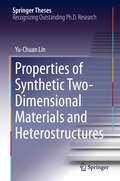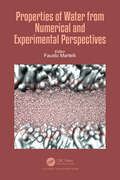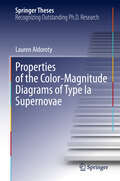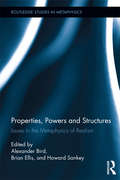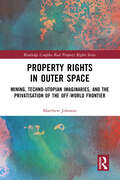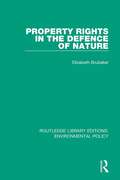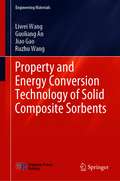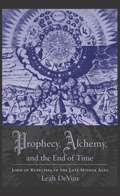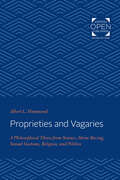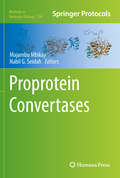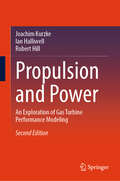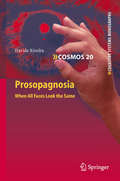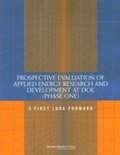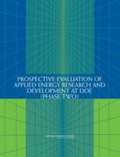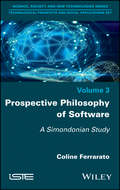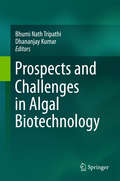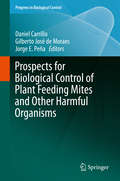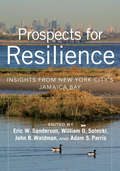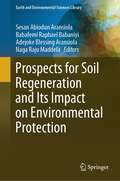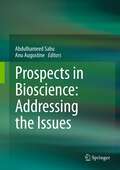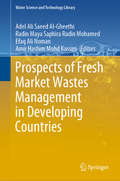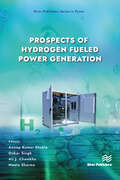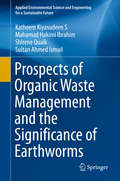- Table View
- List View
Properties of Synthetic Two-Dimensional Materials and Heterostructures (Springer Theses)
by Yu-Chuan LinThis book represents a significant advance in our understanding of the synthesis and properties of two-dimensional (2D) materials. The author’s work breaks new ground in the understanding of a number of 2D crystals, including atomically thin transition metal dichalcogenides, graphene, and their heterostructures, that are technologically important to next-generation electronics. In addition to critical new results on the direct growth of 2D heterostructures, it also details growth mechanisms, surface science, and device applications of “epi-grade” 2D semiconductors, which are essential to low-power electronics, as well as for extending Moore’s law. Most importantly, it provides an effective alternative to mechanically exfoliate 2D layers for practical applications.
Properties of Water from Numerical and Experimental Perspectives
by Fausto MartelliAs the most important liquid in our life and one of the most abundant molecules in the universe, water is the least understood substance with a very rich phase diagram (at least 18 crystalline forms and two liquids) and more that 60 dynamical/thermodynamic anomalies whose origins are still under debate. Properties of Water from Numerical and Experimental Perspectives gathers together leading scientists and experts in the field of water. By merging the theoretical/computational point of view with experimental approaches, it presents a state-of-the-art description of the properties of water, enlightening the source of the anomalies of water and describing how such anomalies actively affect the functioning of biological substances.
Properties of the Color-Magnitude Diagrams of Type Ia Supernovae (Springer Theses)
by Lauren AldorotyThis thesis presents a novel analysis of a photometric observational feature of Type Ia Supernovae (SNe Ia), the most precise distance indicators available for cosmological studies. While SNe Ia are crucial for understanding modern cosmology, there are systematic uncertainties associated with them that prevent use to their full potential. It is therefore vital that sources of systematic error in SN Ia standardization are better understood. In this thesis, the author robustly connects the color-magnitude diagram to SN Ia spectra and their physics for the first time, and shows that for the SN sample in the dissertation, this feature is important to consider as a contributor to scatter in the Hubble residual. There is no prior work in the literature that examines this feature in such depth, and it is rare to be able to paint such a thorough picture in a SN Ia study rooted in a single photometric feature. This work opens up many avenues for future observational and theoretical studies.
Properties, Powers and Structures: Issues in the Metaphysics of Realism (Routledge Studies in Metaphysics)
by Brian Ellis Alexander Bird Howard SankeyWhile the phrase "metaphysics of science" has been used from time to time, it has only recently begun to denote a specific research area where metaphysics meets philosophy of science—and the sciences themselves. The essays in this volume demonstrate that metaphysics of science is an innovative field of research in its own right. The principle areas covered are: The modal metaphysics of properties: What is the essential nature of natural properties? Are all properties essentially categorical? Are they all essentially dispositions, or are some categorical and others dispositional? Realism in mathematics and its relation to science: What does a naturalistic commitment of scientific realism tell us about our commitments to mathematical entities? Can this question be framed in something other than a Quinean philosophy? Dispositions and their relation to causation: Can we generate an account of causation that takes dispositionality as fundamental? And if we take dispositions as fundamental (and hence not having a categorical causal basis), what is the ontological ground of dispositions? Pandispositionalism: Could all properties be dispositional in nature? Natural kinds: Are there natural kinds, and if so what account of their nature should we give? For example, do they have essences? Here we consider how these issues may be illuminated by considering examples from reals science, in particular biochemistry and neurobiology.
Property Rights in Outer Space: Mining, Techno-Utopian Imaginaries, and the Privatisation of the Off-World Frontier (Routledge Complex Real Property Rights Series)
by Matthew JohnsonThis book explores the role of private mining rights in the utopian imaginary of space colonisation. It presents a transdisciplinary account of the new and evolving legislative frameworks that have been established in anticipation of commercial exploitation of the mineral resources of the off-world frontier. Written in an engaging style, the book investigates a novel case study in the history of capitalism and 'the commons': the emergence of a nascent space mining industry, undergirded by a contentious legislative framework. In 2015, the US passed laws that would recognise the claims of US corporations to own and sell space resources. This unilateral act of pre-emptive law-making would appear to contravene the terms of the UN Outer Space Treaty (1967), which declared that the exploration and use of outer space should be ‘for the benefit of all mankind’ and ‘not subject to national appropriation’.Using this central dynamic between privately held mining rights and outer space as a 'global commons', Matthew Johnson constructs an historical sociology of space mining – from the deep historical roots of common and private property to the contemporary networks of neoliberalism that have engaged with the commercialisation of space activity. The anticipatory expansion of private property claims beyond the Earth both resonates with and problematises the ‘terrain’ of political history, such as the tensions between states and markets, public law and private power, ‘the commons’ and exclusive property. The emerging cosmopolitics of off-world private property mirrors (and is often explicitly embedded within) neoliberal geopolitics, prompting urgent questions about how we can reaffirm principles of democracy and ‘common heritage’ in the international laws of Earth and space. This book is compelling reading for anyone interested in the social study of space, law, economics, technology, politics and property rights.
Property Rights in the Defence of Nature (Routledge Library Editions: Environmental Policy #6)
by Elizabeth BrubakerFirst published in 1995. In this study, the author provides a lively and accessible account of the failure of the legal regime to protect the environment. Elizabeth Brubaker explores how legal reliance on property rights has been useful in opposing pollution of land and water. This title will be of interest to students of Environmental Studies, as well as to all those interest in a more secure future for the environment.
Property and Energy Conversion Technology of Solid Composite Sorbents (Engineering Materials)
by Liwei Wang Ruzhu Wang Guoliang An Jiao GaoSolid chemisorption technology is an effective form of energy conversion for recovering low-grade thermal energy, but limited thermal conductivity and agglomeration phenomena greatly limit its performance. Over the past 20 years, researchers have explored the use of thermal conductive porous matrix to improve heat and mass transfer performance. Their efforts have yielded composite sorption technology, which is now extensively being used in refrigeration, heat pumps, energy storage, and de-NOx applications. This book reviews the latest technological advances regarding composite solid sorbents. Various development methods are introduced and compared, kinetic models are presented, and different cycles are analyzed.Given its scope, the book will benefit experts involved in developing novel materials and cycles for energy conversion, as well as engineers working to develop effective commercialized energy conversion systems based on solid sorption technology
Prophecy, Alchemy, and the End of Time: John of Rupescissa in the Late Middle Ages
by Leah DeVunIn the middle of the fourteenth century, the Franciscan friar John of Rupescissa sent a dramatic warning to his followers: the last days were coming; the apocalypse was near. Deemed insane by the Christian church, Rupescissa had spent more than a decade confined to prisons-in one case wrapped in chains and locked under a staircase-yet ill treatment could not silence the friar's apocalyptic message. Religious figures who preached the end times were hardly rare in the late Middle Ages, but Rupescissa's teachings were unique. He claimed that knowledge of the natural world, and alchemy in particular, could act as a defense against the plagues and wars of the last days. His melding of apocalyptic prophecy and quasi-scientific inquiry gave rise to a new genre of alchemical writing and a novel cosmology of heaven and earth. Most important, the friar's research represented a remarkable convergence between science and religion.In order to understand scientific knowledge today, Leah DeVun asks that we revisit Rupescissa's life and the critical events of his age-the Black Death, the Hundred Years' War, the Avignon Papacy-through his eyes. Rupescissa treated alchemy as medicine (his work was the conceptual forerunner of pharmacology) and represented the emerging technologies and views that sought to combat famine, plague, religious persecution, and war. The advances he pioneered, along with the exciting strides made by his contemporaries, shed critical light on later developments in medicine, pharmacology, and chemistry.
Prophets and Protons: New Religious Movements and Science in Late Twentieth-Century America (New and Alternative Religions #4)
by Benjamin E ZellerThis in-depth study shows how new religious movements offer a variety of strategies for reconciling science and religious faith. By the twentieth century, established religious traditions were forced to grappled with the challenges presented by scientific knowledge and innovation. But emerging religions, still led by a living founder to guide them, found news ways to respond to science. The Hare Krishnas, the Unification Church, and Heaven&’s Gate each found distinct ways to incorporate major findings of modern American science, understanding it as central to their wider theological and social agendas. In Prophets and Photons, Benjamin Zeller examines how these New Religious Movements (NRMs) crafted their views on science during their founding period, and how those views evolved over time. These NRMs shed light on how religious groups—new, old, alternative, or mainstream—could respond to the tremendous growth of power and prestige of science in late twentieth-century America. In this engrossing book, Zeller carefully shows that religious groups had several methods of creatively responding to science, and that the often-assumed conflict-based model of &“science vs. religion&” must be replaced by a more nuanced understanding of how religions operate in our modern scientific world.
Proprieties and Vagaries: A Philosophical Thesis from Science, Horse Racing, Sexual Customs, Religion, and Politics
by Albert L HammondOriginally published in 1961. A constant influence on human action is that of proprieties, personal and social. These attitudes and traditions defining what is proper are largely logical in origin, but chance has a way of upsetting them. Even theory, which is part of human action, is subject to this influence. Dr. Hammond takes a novel approach to this philosophical theme. His topics of discussion include perception, the role of symbols in poetry and science, the definition of good and good use in language, space and the motion of the earth, the psychology of love, attitudes toward gambling, and a defense of horse racing. This unorthodox approach results in an exceptionally imaginative and thought-provoking book as well as a strong defense of deontology.
Proprotein Convertases
by Majambu Mbikay Nabil G. SeidahToday, activation endoproteolysis of secretory proteins is recognized as a fundamental biological mechanism of spatial and temporal regulation of protein activity as well as of diversification of protein functions. In Proprotein Convertases, experts in the field examine detailed methods involving proprotein convertases, the enzymes mediating this endoproteolysis, which reside within or cycle between the various compartments of the secretory pathway. Providing a timely assessment of impact of activation/inactivation endoproteolysis in the secretory pathway, the volume offers a broader perspective on the biochemistry of the PCSKs (proprotein convertases, subtilisin/kexin-type) by exploring structural and functional analogies with bacterial subtilisin and on the enzymology of endoproteolysis itself by describing the involvement in the process of non-PCSK-type such as cathepsin L. Written in the highly successful Methods in Molecular Biology series format, chapters include introductions to their specific topics, lists of the necessary materials and reagents, step-by-step, readily reproducible laboratory protocols, and tips on troubleshooting and avoiding known pitfalls. Meticulous and up-to-date, Proprotein Convertases represents an instructive and useful reference book for all scientists interested in endoproteolytic activation and/or inactivation of secretory proproteins through limited proteolysis, for experts in the field and newcomers to it as well.
Propulsion and Power: An Exploration of Gas Turbine Performance Modeling
by Robert Hill Joachim Kurzke Ian HalliwellThis book is for students, teachers, and practicing engineers and describes an industrial approach to gas turbine engine simulation, mainly for aircraft propulsion. The principles of performance model creation are covered, and the viability and accuracy of model-based performance analyses are demonstrated by their application to real-world examples, where measured data are scarce. Clear distinctions are made between design and off-design models, the keys to success being the recognition of the importance of scaling and validating compressor and turbine maps. This topic is discussed in more detail than in other sources. New descriptions of turbomachinery basics are offered, and it is shown how velocity diagrams can capture the quality of a compressor or turbine stage and the effects of changes. Non-dimensional performance is explained in an unusual way, without referring to higher mathematics. The influence of inlet flow distortion and heat transfer on engine operability during transient operation is also characterized. This second edition contains new material about engine starting and windmilling, supported by how to extend existing compressor and turbine maps down to speeds as low as 1%. Unique material on map interpretation is included. The design and operation of hybrid propulsion systems are also addressed. Not only a valuable engineering textbook but also a good read!
Prosopagnosia
by Davide RivoltaThis book provides readers with a simplified and comprehensive account of the cognitive and neural bases of face perception in humans. Faces are ubiquitous in our environment and we rely on them during social interactions. The human face processing system allows us to extract information about the identity, gender, age, mood, race, attractiveness and approachability of other people in about a fraction of a second, just by glancing at their faces. By introducing readers to the most relevant research on face recognition, this book seeks to answer the questions: "Why are humans so fast at recognizing faces?", "Why are humans so efficient at recognizing faces?", "Do faces represent a particular category for the human visual system?", What makes face perception in humans so special?, "Can our face recognition system fail"?. This book presents the author's findings on face perception during his research studies on both normal subjects and subjects with prosopagnosia, a neurological disorder characterized by the inability to recognize faces. The book describes two known forms of prosopagnosia: acquired prosopagnosia, which is the result of a brain lesion, and congenital prosopagnosia, which refers to a lifelong, developmental impairment of face recognition. Written in a comprehensive and accessible style, this book addresses both experts (cognitive scientists, psychologists, neuroscientists and computer scientists) and the general public, and aims at raising awareness for a debilitating face recognition disorder, such as prosopagnosia, which is often ignored or misdiagnosed as autism, with serious consequences for the affected persons and their families.
Prospective Evaluation Of Applied Energy Research And Development At Doe (phase One): A First Look Forward
by National Research Council of the National AcademiesIn 2001, the National Research Council (NRC) completed a congressionally mandated assessment of the benefits and costs of DOE’s fossil energy and energy efficiency R&D programs, Energy Research at DOE: Was It Worth It? The Congress followed this retrospective study by directing DOE to request the NRC to develop a methodology for assessing prospective benefits. The first phase of this project—development of the methodology—began in December 2003. Phase two will make the methodology more robust and explore related issues, and subsequent phases will apply the methodology to review the prospective benefits of different DOE fossil energy and energy efficiency R&D programs. In developing this project, three considerations were particularly important. First, the study should adapt the work of the retrospective study. Second, the project should develop a methodology that provides a rigorous calculation of benefits and risks, and a practical and consistent process for its application. Third, the methodology should be transparent, should not require extensive resources for implementation, and should produce easily understood results. This report presents the results of phase one. It focuses on adaptation of the retrospective methodology to a prospective context.
Prospective Evaluation Of Applied Energy Research And Development At Doe (phase Two)
by National Research Council of the National AcademiesThe National Academies Press (NAP)--publisher for the National Academies--publishes more than 200 books a year offering the most authoritative views, definitive information, and groundbreaking recommendations on a wide range of topics in science, engineering, and health. Our books are unique in that they are authored by the nation's leading experts in every scientific field.
Prospective Philosophy of Software: A Simondonian Study
by Coline FerraratoComputer software (operating systems, web browsers, word processors, etc.) structure our daily lives. Comprising both a user interface and the electronic circuits of the machine it is printed to, software represents a hybrid object at the crossroads of materiality and immateriality. But is it, strictly speaking, a "technical object"? By examining the status of software against the criteria of philosophy of classic techniques, in particular that of Gilbert Simondon, this book lays the groundwork of a philosophical reflection on this subject. Further, in order to help introduce readers to problematics, lines of code and explanatory schemas have been provided.
Prospects and Challenges in Algal Biotechnology
by Bhumi Nath Tripathi Dhananjay KumarThis contributed volume presents the latest research and state-of-the-art approaches in the study of microalgae. It describes in detail technologies for the cultivation of marine, freshwater and extremophilic algae, as well as phototrophic biofilms, cyanobacterial mats and periphytons, including the media requirements and growth rates of different types of algae. The second part of the book is dedicated to the biotechnological applications of algal biomass and secondary metabolites produced by these organisms, and critically discusses topics such as algae-based biofuels and CO2 sequestration. In addition, it reviews the prospects and challenges of algal bioremediation of domestic and industrial wastewaters, including the use of planktonic and self-immobilized algae systems in wastewater treatment, explaining their merits and drawbacks. Lastly, it highlights research methods and approaches related to the production of high-value products and bioactive compounds.
Prospects and Utilization of Tropical Plantation Trees
by Kang Chiang LiewLarge numbers of tropical trees from natural forests or plantation forest are available for human consumption and management. This book focuses on the prospects and utilization of tropical plantation trees in context of economic and business, planting, managing stocks, and uses of trees converted to various wood-based products. It provides information on key areas of tropical plantation trees including growth performance, nursery practices, soil properties, planting stock production, raw material cellulose, anatomy, pulping and papermaking, fiber modification, and properties of wood composites. Features: Comprehensive information on prospects and utilization of tropical plantation tree species. Features information on potential products derived from tropical plantation trees including cellulose-based wood products, particleboard with bioplastic binder, and laminated veneer lumber. Discusses species usage of economic importance other than wood production. Presents information on nursery practices, growth performance, and soil properties of tropical trees. Illustrates methodologies for repeating investigations on work that has been done previously in tropical tree research. This book introduces information for entrepreneurs or researchers before undertaking work with these tree species illustrating technical methodologies allowing for repetition or previous successful works. This information proves valuable to researchers if further work is needed for improvement on these plant-derived products.
Prospects for Biological Control of Plant Feeding Mites and Other Harmful Organisms
by Daniel Carrillo Gilberto José Moraes Jorge E. PeñaThe history of biological control of harmful organisms by mites is marked by outstanding achievements with a few premiere natural enemies. Early works concentrated on the use of predatory mites for the control of synanthropic flies, More recently, the focus has been mostly on mites of the family Phytoseiidae for the control of plant feeding mites. This is an important family of acarine predators of plant pest mites, which are effectively used in agriculture worldwide. Besides the vast knowledge in several species in this family, there are as well many opportunities for biological control, represented in an array of organisms and through the improvement of management techniques, which are constantly explored by researchers worldwide. This has resulted in an increasing interest in predatory mite species within the families Stigmaeidae, Ascidae, Laelapidae, Rhodacaroidea, Macrochelidae, Erythraeidae and Cheyletidae, among others. This book will compile important developments with predatory mite species within these families, which are emerging as important tools for integrated pest management. New developments with predatory insects and pathogenic organisms attacking mites will also be a subject of this book. Finally, the potential and gaps in knowledge in biological control of acarine plant pests will be addressed.
Prospects for Resilience: Insights from New York City's Jamaica Bay
by William D. Solecki John R. Waldman Eric W. Sanderson Adam S. ParrisGiven the realities of climate change and sea-level rise, coastal cities around the world are struggling with questions of resilience. Resilience, at its core, is about desirable states of the urban social-ecological system and understanding how to sustain those states in an uncertain and tumultuous future. How do physical conditions, ecological processes, social objectives, human politics, and history shape the prospects for resilience? Most books set out "the answer." This book sets out a process of grappling with holistic resilience from multiple perspectives, drawing on the insights and experiences of more than fifty scholars and practitioners working together to make Jamaica Bay in New York City an example for the world.Prospects for Resilience establishes a framework for understanding resilience practice in urban watersheds. Using Jamaica Bay--the largest contiguous natural area in New York, home to millions of New Yorkers, and a hub of global air travel with John F. Kennedy International Airport--the authors demonstrate how various components of social-ecological systems interact, ranging from climatic factors to plant populations to human demographics. They also highlight essential tools for creating resilient watersheds, including monitoring and identifying system indicators; computer modeling; green infrastructure; and decision science methods. Finally, they look at the role and importance of a "boundary organization" like the new Science and Resilience Institute at Jamaica Bay in coordinating and facilitating resilience work, and consider significant research questions and prospects for the future of urban watersheds.Prospects for Resiliencesets forth an essential foundation of information and advice for researchers, urban planners, students and others who need to create more resilient cities that work with, not against, nature.
Prospects for Soil Regeneration and Its Impact on Environmental Protection (Earth and Environmental Sciences Library)
by Naga Raju Maddela Sesan Abiodun Aransiola Babafemi Raphael Babaniyi Adejoke Blessing AransiolaSoil is a complex system of inorganic and organic materials, living organisms, water, and air. It is home to more than one trillion species of microorganisms. Soil also plays an important role in the global carbon cycle. Because plants absorb carbon from the atmosphere, convert it to plant tissue, and return it to the soil as plant residue, soils globally act as the world’s largest sink of active carbon. Soil has role to play in food production and safety. Soil contamination undermined by modern agricultural practices that deplete soil carbon stocks. Anthropogenic greenhouse gas emissions have been raising recorded temperatures since the Industrial Revolution. Greenhouse gas emissions from agriculture, forestry, and fisheries have almost doubled in the last 50 years and will increase by 30% by 2050 given the current trend. The primacy of arresting climate change is nowhere more evident than the adoption of 195 countries of the first legally binding global climate deal at the Paris Climate Conference in 2015. With atmospheric carbon dioxide (CO2) reaching 400 parts per million in 2016, soils can be an ally in bringing the CO2 level down to a sustainable level if protected for regeneration. Soil protection and regeneration is a technique that involves the conservative rehabilitation of soil ecosystem and farmland. This technique focuses on top soil regeneration, improving the water cycle, supporting biosequestration, enhancing ecosystem services, increasing biodiversity, strengthening the vitality and health of farm soil, and increasing resilience to climate change and landscape. Environmental protection not only improves soil health, productivity, and resilience to weather extremes, raising farm yields and income while strengthening regional food security in the face of a changing climate, but can also form part of a region’s broader climate strategy. This book is timely as more studies and reviews need to be reported about regenerating global polluted soil and the impacts on the environment, the benefit of both biotic and abiotic structure, thereby creating more awareness of environmental protection and sustainability. Thus, this book presents a vista to research on regeneration of lost resources in the soil and its impacts on the environment.
Prospects in Bioscience: Addressing the Issues
by Abdulhameed Sabu Anu AugustineThe book entitled "Prospects in Bioscience: Addressing the issues" is a collection of selected research papers presented at the International Conference on Advances in Biological Sciences (ICABS) organized by the Department of Biotechnology and Microbiology and the Inter University Centre for Bioscience, Kannur University, Kerala, India. ICABS witnessed a unique spectrum of Scientific Programmes on the most recent and exciting developments in modern biology. The conference displayed the numerous breakthroughs and significant developments in the important areas of modern biology and their relevance to the welfare of global society. The Book contains 50 well written chapters, each one discussing scientifically organized findings of original research work done in reputed laboratories. Needless to say, they deal with advances in various disciplines of modern biology including Cell and Molecular Biology, Structural Biology, Industrial and Environmental Biotechnology, Food and Agricultural Biotechnology and Medical Biotechnology. As the title rightly indicates, the chapters project the prospects in the respective areas and the issues in them. Specific issues discussed in the book includes development of transgenic plants, bioremediation of toxic industrial effluents, biotransformation for novel antibiotics, biofertilizer development, molecular drug designing and structure elucidation, molecular identification of pathogens, production of anti microbials, biocontrol agents and bioactive molecules, cancer biology, plant breeding and hybrid seed production etc. The book with its contents spreading across the vast arena of modern biology is expected to cater to the need of researchers, technologists and students.
Prospects of Fresh Market Wastes Management in Developing Countries (Water Science and Technology Library #92)
by Radin Maya Saphira Radin Mohamed Adel Ali Saeed Al-Gheethi Amir Hashim Mohd Kassim Efaq Ali NomanThis book focuses on the prospects of fresh market waste management in developing countries. It characterizes fresh market wastewater and solid wastes, and highlights the human health impact of corresponding waste management practices. With regard to treatment technologies, the book discusses the anaerobic digestion of fresh solid wastes; the application of natural coagulants for wastewater treatment; the remediation of xenobiotics in wastewater using nanotechnology; and biofilter aquaponic systems for nutrient removal. All of these technologies are recent innovations, offer several concrete advantages, and can be applied in developing countries as non-central treatment systems. In addition, the book covers electricity production from fresh solid wastes using microbial fuel cells, demonstrating the potential held by recycling fresh market wastewater and solid wastes.
Prospects of Hydrogen Fueled Power Generation (River Publishers Series in Power)
by Anoop Kumar Shukla Onkar Singh Meeta Sharma Ali J. ChamkhaProspects of Hydrogen-fueled Power Generation brings together experts to explore the various challenges and opportunities of hydrogen as a fuel in power generation, transportation, storage, and safety. Special interest is given to proton exchange membrane fuel cell (PEMFC) fuel cells, hydrogen energy, and the conversion methods. The usage of clean fuel in road transportation, marine transportation, and the power generation sector are also discussed in detail. Additionally, performance investigations reveal information about the system's energy and exergy analysis.Hydrogen-fueled power generation is the process of generating electricity using hydrogen as the primary fuel source. This process typically involves the conversion of hydrogen into electricity using fuel cells or combustion engines. Fuel cells are electrochemical devices that convert hydrogen into electricity and water with no emissions other than water vapor. Combustion engines, on the other hand, burn hydrogen to produce heat, which is used to generate electricity through a turbine. The byproducts of hydrogen combustion are water and heat, with no harmful emissions. One advantage of hydrogen-fueled power generation is that it produces no harmful emissions, making it a clean and sustainable source of energy. Additionally, hydrogen is a highly abundant element that can be produced from a variety of sources, including natural gas, biomass, and renewable energy sources like solar and wind power.
Prospects of Organic Waste Management and the Significance of Earthworms
by Katheem Kiyasudeen S Mahamad Hakimi Ibrahim Shlrene Quaik Sultan Ahmed IsmailThe main aim of this book is to bridge the gap between aerobic and anaerobic waste treatments by concentrating on studies of earthworms. In particular, vermicomposting is being discussed as well as its properties and applications. Other subjects touch on the treatment of palm oil mill effluents, the various importance of earthworms, its scope and future aspects of earthworm research, and the impact of waste management practices on human health.
